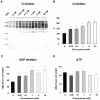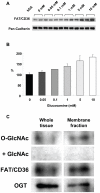Acute regulation of cardiac metabolism by the hexosamine biosynthesis pathway and protein O-GlcNAcylation
- PMID: 21494549
- PMCID: PMC3073970
- DOI: 10.1371/journal.pone.0018417
Acute regulation of cardiac metabolism by the hexosamine biosynthesis pathway and protein O-GlcNAcylation
Abstract
Objective: The hexosamine biosynthesis pathway (HBP) flux and protein O-linked N-acetyl-glucosamine (O-GlcNAc) levels have been implicated in mediating the adverse effects of diabetes in the cardiovascular system. Activation of these pathways with glucosamine has been shown to mimic some of the diabetes-induced functional and structural changes in the heart; however, the effect on cardiac metabolism is not known. Therefore, the primary goal of this study was to determine the effects of glucosamine on cardiac substrate utilization.
Methods: Isolated rat hearts were perfused with glucosamine (0-10 mM) to increase HBP flux under normoxic conditions. Metabolic fluxes were determined by (13)C-NMR isotopomer analysis; UDP-GlcNAc a precursor of O-GlcNAc synthesis was assessed by HPLC and immunoblot analysis was used to determine O-GlcNAc levels, phospho- and total levels of AMPK and ACC, and membrane levels of FAT/CD36.
Results: Glucosamine caused a dose dependent increase in both UDP-GlcNAc and O-GlcNAc levels, which was associated with a significant increase in palmitate oxidation with a concomitant decrease in lactate and pyruvate oxidation. There was no effect of glucosamine on AMPK or ACC phosphorylation; however, membrane levels of the fatty acid transport protein FAT/CD36 were increased and preliminary studies suggest that FAT/CD36 is a potential target for O-GlcNAcylation.
Conclusion/interpretation: These data demonstrate that acute modulation of HBP and protein O-GlcNAcylation in the heart stimulates fatty acid oxidation, possibly by increasing plasma membrane levels of FAT/CD36, raising the intriguing possibility that the HBP and O-GlcNAc turnover represent a novel, glucose dependent mechanism for regulating cardiac metabolism.
Conflict of interest statement
Figures





References
-
- An D, Rodrigues B. Role of changes in cardiac metabolism in development of diabetic cardiomyopathy. Am J Physiol Heart Circ Physiol. 2006;291:H1489–1506. - PubMed
-
- Boudina S, Abel ED. Diabetic cardiomyopathy revisited. Circulation. 2007;115:3213–3223. - PubMed
-
- Randle PJ, Garland PB, Hales CN, Newsholme EA. The glucose fatty-acid cycle: Its role in insulin sensitivity and metabolic disturbances of diabetes mellitus. The Lancet. 1963;1:785–789. - PubMed
-
- Buchanan J, Mazumder PK, Hu P, Chakrabarti G, Roberts MW, et al. Reduced cardiac efficiency and altered substrate metabolism precedes the onset of hyperglycemia and contractile dysfunction in two mouse models of insulin resistance and obesity. Endocrinology. 2005;146:5341–5349. - PubMed
-
- Torres CR, Hart GW. Topography and polypeptide distribution of terminal N-acetylglucosamine residues on the surfaces of intact lymphocytes. Evidence for O-linked GlcNAc. J Biol Chem. 1984;259:3308–3317. - PubMed
Publication types
MeSH terms
Substances
Grants and funding
LinkOut - more resources
Full Text Sources
Other Literature Sources
Miscellaneous

